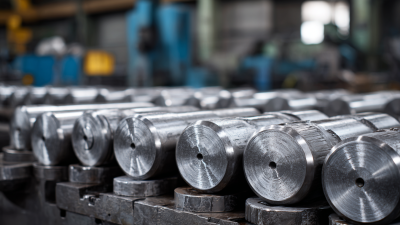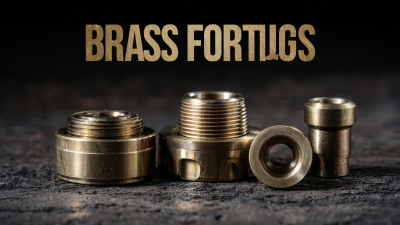Leave Your Message
-
Phone
-
E-mail
In the world of manufacturing, the performance of forged steel parts is pivotal to the overall success of numerous applications across various industries. As the demand for high-strength, durable components continues to rise, innovative solutions have emerged to enhance the capabilities of these essential materials. This blog delves into a comparative analysis of cutting-edge techniques and technologies that can significantly improve the performance of forged steel parts.

From advanced heat treatments to innovative surface coatings, we will explore how these solutions address critical challenges such as wear resistance, fatigue strength, and weight reduction. By examining various approaches and their outcomes, this discussion aims to illuminate the best practices for optimizing forged steel parts, thereby driving efficiency and sustainability in production processes.
The selection of advanced materials is critical for enhancing the performance of forged steel parts, especially as industries pivot towards more sustainable and efficient manufacturing processes. Recent findings highlight the increasing complexity in machinability for difficult-to-machine alloys, necessitating improved lubrication and cooling techniques. Different methods such as dry, flood, and minimum quantity lubrication (MQL) play a pivotal role in achieving optimal performance while maintaining cost-efficiency. A comprehensive review indicates that the right cooling strategy can significantly impact tool wear and surface finish, ultimately influencing the overall integrity of forged steel components.
Furthermore, advancements in manufacturing technologies, such as metal additive manufacturing, are shaping the landscape of forged steel production. Recent analyses emphasize the need for continuous innovation to mitigate challenges like defect formation and process optimization. As the market trends prioritize lightweight and sustainable materials, incorporating such technologies can lead to enhanced performance of steel parts while supporting environmental sustainability. With ongoing investments and job creation in the sector, the future of forged steel production is poised to embrace these innovative strategies, aligning with global demands for both quality and sustainability.
The performance of forged steel parts is significantly influenced by innovative heat treatment techniques, which enhance their durability and overall functionality. By optimizing the heat treating process, manufacturers can improve the mechanical properties of forged steel components, making them more resilient under various operational conditions. Recent advancements in techniques such as high-pressure heat treatments have demonstrated the potential for increased strength and performance, directly addressing the growing demand for durable materials in various industrial applications.
Tips for enhancing the heat treatment process include implementing advanced thermal treatment parameters and exploring non-conventional methods that can offer improved results. For instance, adopting novel strategies for heat transfer can lead to more effective and uniform heat distribution, thus maximizing the durability of forged steel parts. Such innovations not only bolster the structural integrity of components but also align with sustainability goals, providing avenues for waste reduction and increased efficiency in production processes.
Investing in research and development focused on state-of-the-art heat treatment methods can yield significant benefits. Companies should prioritize continuous learning about the latest innovations and their applications, as this knowledge can be pivotal in achieving superior performance and redefining market standards in forged steel manufacturing.
Coatings and surface treatments play a pivotal role in enhancing the performance of forged steel parts, addressing challenges related to wear resistance, corrosion, and fatigue life. A report from the International Journal of Mechanical Sciences indicates that surface modifications can increase surface hardness by up to 70%, significantly extending the lifespan of steel components in demanding applications. Techniques such as thermal spraying, nitriding, and PVD (physical vapor deposition) coatings are increasingly utilized in industries ranging from automotive to aerospace, where extreme conditions are common.
Moreover, the implementation of advanced surface treatments contributes to improved tribological properties, reducing friction and minimizing wear. According to a study published in the Journal of Materials Processing Technology, parts treated with wear-resistant coatings displayed a reduction in friction coefficients by more than 30% compared to untreated counterparts. This not only enhances efficiency but also translates into substantial cost savings for manufacturers, further emphasizing the importance of innovative solutions in optimizing the performance of forged steel parts. Such advancements are essential for meeting the growing demands for durability and reliability in today's high-performance environments.

In the forging industry, the integration of real-time data analytics has emerged as a transformative approach to enhance the performance of forged steel parts. According to a report by MarketsandMarkets, the industrial analytics market is expected to grow from $26 billion in 2020 to over $60 billion by 2025, indicating a significant trend towards data-driven methodologies. By applying real-time analytics during the forging process, manufacturers can monitor variables such as temperature, pressure, and material flow. This data allows for immediate adjustments, ensuring optimal conditions are maintained throughout production, enhancing both yield and quality.

Moreover, the predictive capabilities afforded by real-time analytics contribute substantially to reducing production downtime. A study conducted by Deloitte reveals that manufacturers utilizing predictive analytics can decrease maintenance costs by up to 25% while simultaneously increasing productivity. By effectively leveraging these insights, companies can anticipate potential failures or inefficiencies, thereby streamlining operations and maximizing the performance of forged steel parts. As the forging sector continues to evolve, embracing data-driven technologies will be crucial in maintaining a competitive edge in the market.
Additive manufacturing (AM) is revolutionizing the production of forged steel components by offering innovative solutions to enhance performance and efficiency. According to a report by MarketsandMarkets, the global additive manufacturing market for metals is projected to reach $7.5 billion by 2026, growing at a compound annual growth rate (CAGR) of 24.3%. This significant growth highlights the increasing adoption of AM technologies in industries that demand high-performance components, such as aerospace and automotive.
By integrating additive manufacturing with traditional forging processes, manufacturers can create complex geometries that were previously impossible to achieve. For instance, AM allows for the production of lightweight structures while maintaining high strength-to-weight ratios, a crucial factor in sectors like aerospace, where every gram counts. The ability to optimize designs using advanced software tools, coupled with the flexibility of AM, enables engineers to enhance the mechanical properties of forged steel components, leading to improved durability and performance under extreme conditions. A study by ASTM International reveals that parts produced through additive techniques have shown up to 30% better fatigue resistance compared to their conventionally forged counterparts. As these technologies advance, the potential for enhancing forged steel parts is boundless, paving the way for future innovations.
| Dimension | Traditional Forged Steel Components | Additively Manufactured Components | Performance Improvement (%) |
|---|---|---|---|
| Weight | 100 kg | 90 kg | 10% |
| Tensile Strength | 300 MPa | 400 MPa | 33.33% |
| Yield Strength | 250 MPa | 340 MPa | 36% |
| Impact Toughness | 40 J | 60 J | 50% |
| Fatigue Resistance | 2 x 10^6 cycles | 3 x 10^6 cycles | 50% |






